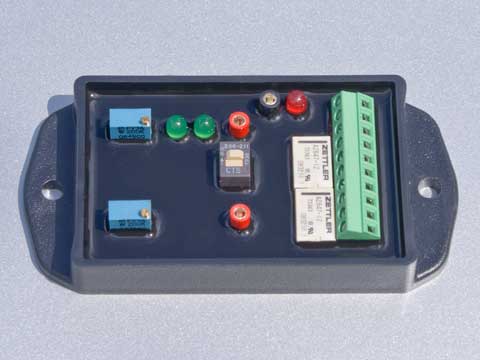In a nutshell, the problem we are trying to solve is a simple one. Any technology that is increasing the efficiency of combustion of your petroleum based fuel, will cause additional oxygen to appear in the exhaust. This additional oxygen is sensed by your oxygen sensors, and this information is forwarded to the vehicle’s computer. The computer then thinks that the air/fuel mix is too lean, and then richens the mix incorrectly.
The solution is then equally simple. We just need to compensate for this factor of the additional oxygen in the exhaust. By doing this, we unlock all of the latent gains your particular fuel saving device has to offer. This is where the EFIE comes in. EFIE stands for Electronic Fuel Injection Enhancer. The purpose of the EFIE is to make the needed adjustments to the oxygen sensor’s signal.
Click Below to Purchase a Narrow band Dual Digital EFIE for you system
Vehicles 96 and older (4cyl)
There are 2 basic kinds of oxygen sensor. They are called “narrow band” and the more modern, and superior, “wide band” oxygen sensor. The most important distinction is which of these 2 types of oxygen sensors you have. An EFIE made for one type will not work on the other. If you have any doubt about this point, you can contact us and let us look up your vehicle to be sure.
It is often easy to figure out what type of sensors you have. Is your car pre 1997? Then it’s narrow band. Is it an American Car? It’s narrow band (we’ve now seen a few wide bands in 2009 American cars, but none before that). If it is a German or Japanese make and was built after 2000, then you should suspect that it has wide band sensors. Actually a very few cars started using wide band sensors in 1997, but it is only after 2000 that they are used with any regularity. But here’s another test: Does the sensor have more than 4 wires? If it does, then its a wide band sensor. Note that Toyota and Honda uses a 4-wire wide band oxygen sensor. All other makes use 5-wire or 6-wire wide band sensors.
Click below to Purchase Narrow band Quad Digital EFIE
Vehicles 96 and older ( V6 and V8)
Here’s another way to tell: Open your hood. Now look up. Do you see a sticker up under the hood with technical data about your vehicle? Often if you have wide band sensors, they are noted on these stickers for the mechanics. Note that it may be called an AFR (Air/Fuel Ratio) sensor, or AFS (Air/Fuel Sensor). These are all synonyms for a wide band oxygen sensor.
One other point: If you have wide band sensors upstream of the catalytic converter, you will still have narrow band sensors downstream. As of this date (2009), we have never seen wide band oxygen sensors being used downstream.
Number of Sensors
The next point is, “how many sensors do you have?”. V-6, V-8 and larger, usually have 2 sensors that are upstream of the catalytic converter, one on each exhaust manifold. Further, they will have 1 or 2 downstream sensors as well. Note: some pre-1996 vehicles don’t have downstream sensors. Vehicles with 4 cylinder engines usually have 1 upstream sensor, and 1 downstream sensor. You will occasionally run into some oddball configurations that vary from these, but these are the usual configurations.
We recommend that you treat all oxygen sensors regardless of whether they are upstream or downstream. Many manufacturers are now using the downstream sensors in their air/fuel calculations, and others are using them to check the function of the upstream sensors, causing odd trouble lights and poor mileage gains. Because this has become so prevalent, we designed our products to include EFIEs for both the upstream and downstream oxygen sensors. Please see our Dual Digital EFIE Series, Quad digital EFIE Series and our Wide Band EFIE Series. These products include the correct combination of EFIEs to treat both your upstream and downstream sensors.
For instance, the Quad Digital EFIE has 2 digital EFIEs for treating 2 upstream narrow band oxygen sensors, and 2 analog EFIEs for treating 2 downstream sensors. Using analog EFIEs on the downstream sensors was not a cost saving consideration. We have found that analog EFIEs work better on downstream sensors, while digital EFIEs are clearly superior working on upstream sensors. For more information on why this is so, please see
HHO Joe’s Take on Volo FS2-HHO Chip
The Volo chip works great! It is designed to communicate with your vehicles ECU and selects the the best maps for performance and fuel economy alongside an Qaulity HHO system by taking control of your vehicles o2/map/maf sensors.It works with vehicles with an OBDII port that are 1997 and newer and we have a program for that vehicles year/make/model.Check here for Sales on Our Volo FS2-HHO chipNow a message From Volo Performance on the FS2-HHO Chip
The FS2 is our newest performance chip, based on the powerful VP12.
This chip has been specifically tuned for the needs of HHO generator equipped vehicles. The FS2 is dynamic – which means the FS2 will consider oxygen levels in the exhaust, along with engine speed and load, intake air temperature and volume, and many other variables to determine the most efficient fuel delivery rate and timing at up to 256 separate load points.
When using HHO as a fuel supplement, the FS2 will adjust fuel delivery and timing to optimize efficiency.
When HHO is disabled, the FS2 will automatically re-adjust and switch to highly efficient, non-HHO enhanced maps.
The FS2 is a vehicle specific, custom programmed 20MHz Microcontroller. It utilizes its high speed serial input/output to communicate directly with the ECU through the OBD-II port.



